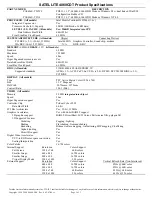
2–2
Safety & Comfort Guide
Finding Your Comfort Zone
A Range of Positions
Rather than working in a single posture, find your
comfort
zone
. Your comfort zone is a
range of positions that is
generally appropriate and comfortable for your given work
situation.
Move
Sitting still for long periods can cause discomfort and
muscle fatigue. Changing postures is good for many parts
of your body, including your spine, joints, muscles, and
circulatory system.
❒
Within your comfort zone, change postures often
throughout the day.
❒
Take frequent short breaks: stand up, carefully stretch,
or walk around.
❒
Frequently switch to brief tasks that require getting up,
such as retrieving output from a printer, filing
paperwork, or consulting a colleague down the hall.
❒
If your furniture offers a wide range of adjustments,
you might find it comfortable to switch back and forth
between sitting and standing positions.
Different Tasks, Different Postures
Your choice of posture within your comfort zone may vary
with your task. For example, you may find a slightly
reclined posture most comfortable for computer tasks,
and a more upright posture more comfortable for tasks
requiring frequent reference to papers or books.
Organizing Your Adjustments
The order in which you make various adjustments to your
body position and work area may vary depending on the
adjustability of your furniture. For tips on how to order your
adjustments,
refer to Chapter 5, “Organizing Your
Adjustments.”
TIP
That afternoon
slump
Pay particular
attention to adjusting
your posture in the
afternoon when you
may tend to get
fatigued.
AVOID!
◆
Do not sit in one
fixed posture all
day.
◆
Avoid slouching
forward.
◆
Be sure not to lean
back too far.













































